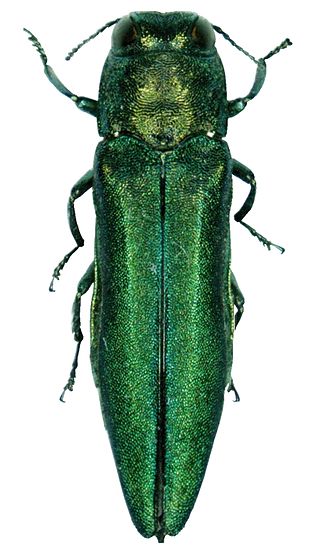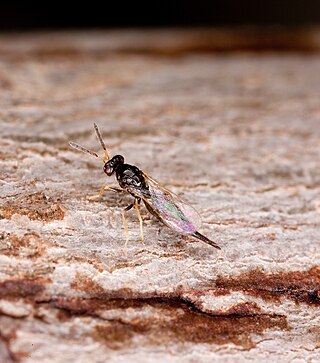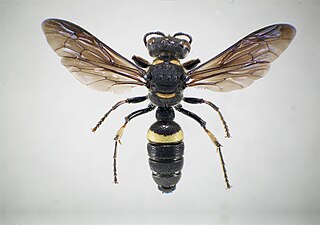
Fraxinus, commonly called ash, is a genus of plants in the olive and lilac family, Oleaceae, and comprises 45–65 species of usually medium-to-large trees, most of which are deciduous trees, although some subtropical species are evergreen trees. The genus is widespread throughout much of Europe, Asia, and North America.

Fraxinus americana, the white ash or American ash, is a species of ash tree native to eastern and central North America.

Biological control or biocontrol is a method of controlling pests, whether pest animals such as insects and mites, weeds, or pathogens affecting animals or plants by using other organisms. It relies on predation, parasitism, herbivory, or other natural mechanisms, but typically also involves an active human management role. It can be an important component of integrated pest management (IPM) programs.

The emerald ash borer, also known by the acronym EAB, is a green buprestid or jewel beetle native to north-eastern Asia that feeds on ash species. Females lay eggs in bark crevices on ash trees, and larvae feed underneath the bark of ash trees to emerge as adults in one to two years. In its native range, it is typically found at low densities and does not cause significant damage to trees native to the area. Outside its native range, it is an invasive species and is highly destructive to ash trees native to Europe and North America. Before it was found in North America, very little was known about emerald ash borer in its native range; this has resulted in much of the research on its biology being focused in North America. Local governments in North America are attempting to control it by monitoring its spread, diversifying tree species, and through the use of insecticides and biological control.

Fraxinus pennsylvanica, the green ash or red ash, is a species of ash native to eastern and central North America, from Nova Scotia west to southeastern Alberta and eastern Colorado, south to northern Florida, and southwest to Oklahoma and eastern Texas. It has spread and become naturalized in much of the western United States and also in Europe from Spain to Russia.

The Braconidae are a family of parasitoid wasps. After the closely related Ichneumonidae, braconids make up the second-largest family in the order Hymenoptera, with about 17,000 recognized species and many thousands more undescribed. One analysis estimated a total between 30,000 and 50,000, and another provided a narrower estimate between 42,000 and 43,000 species.

Parasitoid wasps are a large group of hymenopteran superfamilies, with all but the wood wasps (Orussoidea) being in the wasp-waisted Apocrita. As parasitoids, they lay their eggs on or in the bodies of other arthropods, sooner or later causing the death of these hosts. Different species specialise in hosts from different insect orders, most often Lepidoptera, though some select beetles, flies, or bugs; the spider wasps (Pompilidae) exclusively attack spiders. More rarely, parasitoid wasps may use plant seeds as hosts, such as Torymus druparum.

Fraxinus mandshurica, the Manchurian ash, is a species of Fraxinus native to northeastern Asia in northern China, Korea, Japan and southeastern Russia.

A wasp is any insect of the narrow-waisted suborder Apocrita of the order Hymenoptera which is neither a bee nor an ant; this excludes the broad-waisted sawflies (Symphyta), which look somewhat like wasps, but are in a separate suborder. The wasps do not constitute a clade, a complete natural group with a single ancestor, as bees and ants are deeply nested within the wasps, having evolved from wasp ancestors. Wasps that are members of the clade Aculeata can sting their prey.

The Doryctinae or doryctine wasps are a large subfamily of braconid parasitic wasps (Braconidae). Numerous genera and species formerly unknown to science are being described every year. This subfamily is presumably part of a clade containing otherwise any or all of the Alysiinae, Braconinae, Gnamptodontinae, Opiinae and Ypsistocerinae, and might be most closely related to the last one of these. Whether the Rogadinae are also part of this group is not known.

Tetrastichus is a genus of hymenopteran insects of the family Eulophidae.

Cerceris fumipennis, the only species of buprestid-hunting Crabronidae occurring in eastern North America, is found throughout the continental United States east of the Rockies: from Texas and Florida north to Maine, Wyoming, and into Canada. The wasps most often nest in open areas of hard-packed sandy soil surrounded by woody habitat suitable for their buprestid beetle prey.

Tetrastichus planipennisi is a parasitic non-stinging wasp of the family Eulophidae which is native to North Asia. It is a parasitoid of the emerald ash borer, an invasive species which has destroyed tens of millions of ash trees in its introduced range in North America. As part of the campaign against the emerald ash borer (EAB), American scientists in conjunction with the Chinese Academy of Forestry searched since 2003 for its natural enemies in the wild leading to the discovery of several parasitoid wasps, including Tetrastichus planipennisi which is a gregarious endoparasitoid of EAB larvae on Manchurian Ash and has been recorded to attack and kill up to 50 percent of EAB larvae.

Oobius agrili is a parasitic non-stinging wasp of family Encyrtidae which is native to North Asia. It is a parasitoid of the emerald ash borer, an invasive species which has destroyed tens of millions of ash trees in its introduced range in North America. As part of the campaign against the emerald ash borer (EAB), American scientists in conjunction with the Chinese Academy of Forestry searched since 2003 for its natural enemies in the wild leading to the discovery of several parasitoid wasps, including Oobius agrili, which is a solitary egg parasitoid of EAB found on ash trees in Jilin province in 2004; it has been recorded to kill up to 60 percent of EAB eggs.

Dinocampus coccinellae is a braconid wasp parasite of coccinellid beetles, including the spotted lady beetle, Coleomegilla maculata. D. coccinellae has been described as turning its ladybird host into a temporary "zombie" guarding the wasp cocoon. About 25% of Coleomegilla maculata recover after the cocoon they are guarding matures, although the proportion of other ladybird species which recover is much lower.

Scirpophaga incertulas, the yellow stem borer or rice yellow stem borer, is a species of moth of the family Crambidae. It was described by Francis Walker in 1863. It is found in Afghanistan, Nepal, north-eastern India, Sri Lanka, Bangladesh, Myanmar, Vietnam, Thailand, Malaysia, Singapore, Sumatra, Java, Borneo, Sumba, Sulawesi, the Philippines, Taiwan, China and Japan.

Cotesia glomerata, the white butterfly parasite, is a small parasitoid wasp species belonging to family Braconidae. It was first described by Carl Linnaeus in his 1758 publication 10th edition of Systema Naturae.
Cotesia urabae is a small wasp, having a black body with yellow-brown legs, characterized by a solitary larval endoparasitoid stage. It is part of a large complex of 11 primary parasitoids of Uraba lugens Walker, many of which are polyphagous. The female inserts its ovipositor into the a U. lugens larva, depositing its eggs there, and it has been found that one female may carry up to 400 eggs. While C. urabae females are able to attack the same larva several times; only one single parasitoid completes its development in each larva.

Spathius galinae is a parasitoid of emerald ash borer. The known range of S. galinae extends from the Russian Far East to South Korea. It is currently approved for release in some areas of North America as part of a biological control program against emerald ash borer.
Nealiolus curculionis is a species of parasitic wasp in the family Braconidae. It is a parasitoid of the sunflower stem weevil Cylindrocopturus adspersus, and a number of other species of stem-boring weevils.

















